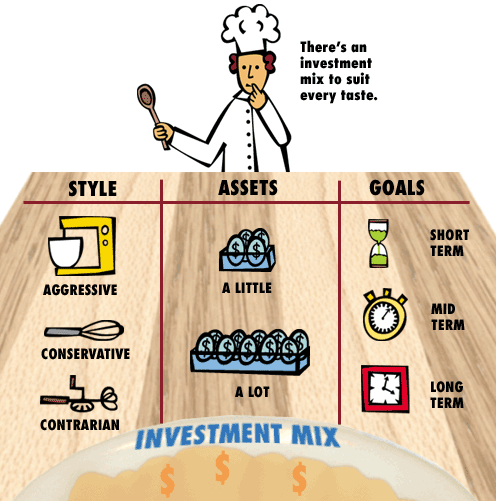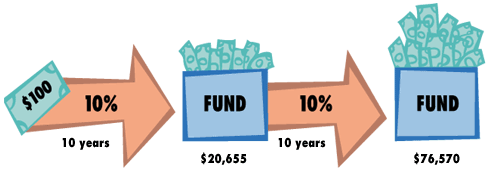Articles
Taking the First Steps
When you buy shares of stock, choose a mutual fund, or inherit things of value that either provide income or…
When you buy shares of stock, choose a mutual fund, or inherit things of value that either provide income or that you can sell for a profit, you’re an investor.
If you continue to invest — either by buying more shares of the stock and funds you already own or selecting new stock and funds — you’re on the road to building an investment portfolio. And if you reinvest any earnings from your existing investments, you can take advantage of the power of compounding, or making money on your earnings, to increase the size and value of your investment base.

JUST GETTING STARTED
You don’t need a lot of money to start investing. Many mutual funds let you open an account with as little as $1,000.
Or, you can open a brokerage account and buy stock as long as you have enough money to make even a single investment. For example, you might purchase 100 shares of a stock priced at $10 a share for $1,000, plus a commission. You may also be able to buy shares directly through the company that issues them using a direct purchase plan or a dividend reinvestment plan.
If you haven’t done it already, it’s usually a good idea to open an investment account that’s separate from your everyday financial accounts. That way you’ll be able to keep track of the money you plan to invest, and you may not be as tempted to spend it. In fact, if you’re investing to meet several goals, some financial advisers suggest opening separate accounts for each goal.
Once an investment account is open, you can add money on a regular schedule, such as 10% of your paycheck each pay period or $100 a month. If that sounds like more than you can afford, think of it this way: $100 a month is less than $3.30 a day.
When you have saved enough to make an investment, you can start the process again. Or, you might prefer to use a stock mutual fund as your investment account. That way you’re invested from the start. And when you’re ready to make additional investments, you can redeem, or cash in, some of your fund shares and use the money to make the new purchase.
THE POWER OF COMPOUNDING
The reason you don’t want to wait to start investing is that time really is money, thanks to the power of compounding.
As soon as you invest, your investments have the potential to begin to generate earnings. And, with compounding, any earnings are reinvested to increase the size of your investment base.
That larger base, in turn, has the potential to produce more earnings, which can again be reinvested.
For example, suppose:
- You invested just $100 a month for 10 years in a mutual fund
- The fund gained value at an average rate of 10% a year
- And you reinvested all your earnings

After 10 years, your hypothetical account would be worth $20,655. After 20 years, assuming the same $100 a month investment, the same 10% average return, and continuing reinvestment, your account would be worth $76,570.
Of course, this result doesn’t reflect the return on an actual investment and investment returns aren’t guaranteed, so you can’t to be sure of earning 10% a year. In fact, in some years, it may be substantially less, though in others, it might be more. And your account may lose value in some years. The annualized return on equity investments in the US has averaged 10.4%, despite ups and downs, since 1926, but that’s before accounting for the affect of taxes or inflation. A more conservative estimate for long-term real return is closer to 7%.
REALIZING CAPITAL GAINS
Investments are also known as capital assets. When you sell a capital asset for more than you paid for it, you realize a capital gain. And if you sell at a lower price than you paid, you realize a capital loss.
To calculate a capital gain, you subtract the price at which you bought the investment from the price you sold it for.
Selling price – Purchase price = CAPITAL GAIN
$5,000 – $3,500 = $1,500
While you own the assets, they may increase or decrease in value, producing unrealized gains or losses. The nice thing about unrealized gains is that your investment can continue to increase in value — which can’t happen once the asset is sold. The downside is that unrealized gains can turn into unrealized losses — which become all too real losses if you sell when the price is down.
INVESTOR PROFILES
If your image of investing is a roller-coaster ride of big gains and equally big losses in rapid, heart-stopping succession, you’re mistaking one tiny segment of the investing community for all investors. In fact, there are almost as many approaches to investing — sometimes called investing styles — as there are people who invest.
Conservative investors are primarily concerned with safeguarding the assets they already have. While they may choose some investments they expect to grow in value, they try to minimize the chance of losing any principal, or the amount they’ve invested.
Moderate investors seek growth from a substantial portion of their portfolio while investing the balance to protect their principal and perhaps provide income.
Aggressive investors concentrate on investments with the potential for significant growth although they run a greater risk of losing some or all of their principal.
Your individual approach may be any one or a combination of these three styles. For example, you might invest some of your portfolio conservatively, most of it moderately, and a small portion aggressively. That combination is sometimes described as an investment pyramid — a base of safety, a main structure of moderation, and a cap of risk.